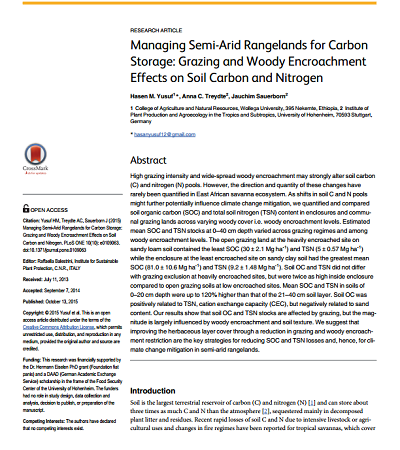
High grazing  intensity and wide-spread woody encroachment may strongly alter soil carbon (C) and nitrogen (N) pools. However, the direction and quantity of these changes have rarely been quantified in East African savanna ecosystem. As shifts in soil C and N pools might further potentially influence climate change mitigation, we quantified and compared soil organic carbon (SOC) and total soil nitrogen (TSN) content in enclosures and communal grazing lands across varying woody cover i.e. woody encroachment levels. Estimated mean SOC and TSN stocks at 0–40 cm depth varied across grazing regimes and among woody encroachment levels. The open grazing land at the heavily encroached site on sandy loam soil contained the least SOC (30 ± 2.1 Mg ha-1) and TSN (5 ± 0.57 Mg ha-1) while the enclosure at the least encroached site on sandy clay soil had the greatest mean SOC (81.0 ± 10.6 Mg ha-1) and TSN (9.2 ± 1.48 Mg ha-1). Soil OC and TSN did not differ with grazing exclusion at heavily encroached sites, but were twice as high inside enclosure compared to open grazing soils at low encroached sites. Mean SOC and TSN in soils of 0–20 cm depth were up to 120% higher than that of the 21–40 cm soil layer. Soil OC was positively related to TSN, cation exchange capacity (CEC), but negatively related to sand content. Our results show that soil OC and TSN stocks are affected by grazing, but the magnitude is largely influenced by woody encroachment and soil texture. We suggest that improving the herbaceous layer cover through a reduction in grazing and woody encroachment restriction are the key strategies for reducing SOC and TSN losses and, hence, for climate change mitigation in semi-arid rangelands.
intensity and wide-spread woody encroachment may strongly alter soil carbon (C) and nitrogen (N) pools. However, the direction and quantity of these changes have rarely been quantified in East African savanna ecosystem. As shifts in soil C and N pools might further potentially influence climate change mitigation, we quantified and compared soil organic carbon (SOC) and total soil nitrogen (TSN) content in enclosures and communal grazing lands across varying woody cover i.e. woody encroachment levels. Estimated mean SOC and TSN stocks at 0–40 cm depth varied across grazing regimes and among woody encroachment levels. The open grazing land at the heavily encroached site on sandy loam soil contained the least SOC (30 ± 2.1 Mg ha-1) and TSN (5 ± 0.57 Mg ha-1) while the enclosure at the least encroached site on sandy clay soil had the greatest mean SOC (81.0 ± 10.6 Mg ha-1) and TSN (9.2 ± 1.48 Mg ha-1). Soil OC and TSN did not differ with grazing exclusion at heavily encroached sites, but were twice as high inside enclosure compared to open grazing soils at low encroached sites. Mean SOC and TSN in soils of 0–20 cm depth were up to 120% higher than that of the 21–40 cm soil layer. Soil OC was positively related to TSN, cation exchange capacity (CEC), but negatively related to sand content. Our results show that soil OC and TSN stocks are affected by grazing, but the magnitude is largely influenced by woody encroachment and soil texture. We suggest that improving the herbaceous layer cover through a reduction in grazing and woody encroachment restriction are the key strategies for reducing SOC and TSN losses and, hence, for climate change mitigation in semi-arid rangelands.








